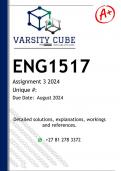ENG1517
Assignment 3 2024
Unique #:
Due Date: August 2024
Detailed solutions, explanations, workings
and references.
+27 81 278 3372
, QUESTION 1
The type of rhyme used in the poem "The Moon" by Robert Louis Stevenson is an
end rhyme. End rhyme occurs when the last words of two or more lines rhyme with
each other.
An example from the poem is:
"The moon has a face like the clock in the hall;
She shines on thieves on the garden wall,"
In these lines, the words "hall" and "wall" rhyme, demonstrating the use of end
rhyme.
The simile in the poem "The Moon" by Robert Louis Stevenson is found in the first
line: "The moon has a face like the clock in the hall."
This simile compares the moon's face to a clock in a hall, suggesting several
effects:
Familiarity and Comfort: By comparing the moon to a clock, an object
commonly found in a household, Stevenson evokes a sense of familiarity
and comfort. This simile makes the moon seem like a constant, reliable
presence, much like a clock is in daily life.
Personification and Imagination: The comparison gives the moon a human-
like quality, with a "face," encouraging readers, especially children, to use
their imagination and see the moon as a friendly, watchful figure in the night
sky.
Time and Continuity: A clock is a symbol of time and continuity, which can
imply that the moon, much like a clock, is a consistent and regular part of
the natural world, keeping a steady watch over the night.
Varsity Cube 2024 +27 81 278 3372




